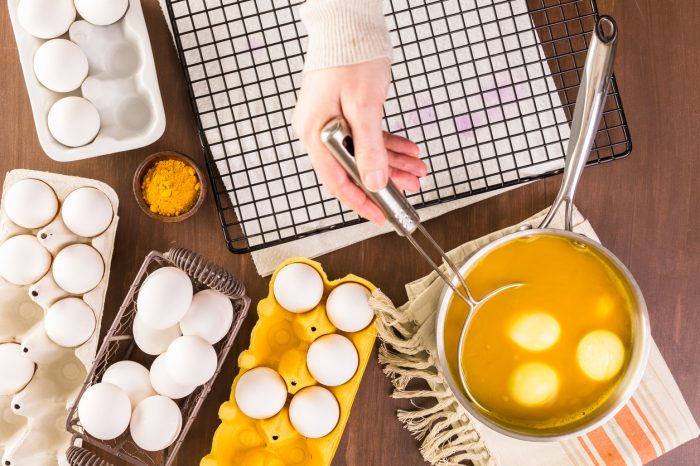Easter is just around the corner and you know what that means! It’s time to bring color and joy to your simple chicken eggs. But what if you don’t want to use the paints sold in grocery stores? Worry not! There are natural Easter egg dyes you can make use of this holiday.
Dyeing eggs has always been a great parent-kid activity in my house when I was growing up. It seemed almost miraculous to me the way the eggs developed rich, vibrant colors in so many shades. And even though my mom was always interested in perfection, I thoroughly enjoyed every small accident with the dyeing. I remember it painted vividly, even now, so many years later.
My mom had tubes of paint. She would wear plastic gloves, add just a drop of paint into her hands, and then gently held the egg in her palms like she was protecting it. Because the boiled eggs were fragile, she would be so careful with them. Sometimes, she would let my sister and me participate in the activity.
And even though my mother would be annoyed when the dye on the eggs would touch something else around it, leaving paint bruises, I loved those asymmetries. They made the eggs special. I say this because I think it’s important that you don’t put too much pressure on yourself to turn out perfect Easter eggs. Just try to have fun with it. And if you have children, involve them, too. Especially with the following natural Easter egg dyes, the activity is simple and safe.
Oh, and have fun on your Easter egg hunt!

How do you make the mixtures?
What you have to do is make the mixtures and then leave the boiled eggs soaking overnight in the colorful liquids, in the refrigerator! That is how you get the richest colors. A vital ingredient in this whole is white vinegar. Mix it in with the ingredients because it helps stabilize the rainbow of colors.
You will have to simmer the fruits, veggies, and other ingredients for a certain amount of time, add as much vinegar as the recipe requires, and then add the hardboiled eggs to them after they’ve cooled off and reached room temperature. After that, pop them in the refrigerator and leave them overnight.
Note: The recipes for natural Easter egg dyes below work mostly for white eggs. When you can use brown eggs, I will let you know.
5 natural Easter egg dyes to try
1. Turmeric
If you’re looking for a wonderful golden color for your Easter eggs, turmeric is your (pardon the pun!) golden ticket. Stir 2 tablespoons of turmeric into one cup of boiling water. Add 2 teaspoons of white vinegar and then let the eggs soak in it overnight, like we’ve talked about above.
Now, if you want to play with different shades of yellow and have a cornucopia of hues on your table (that especially works if you’re making a looot of eggs and are having a lot of people over), you have plenty of options. For a rich yellow, simmer some chopped carrot tops in one and a half cups of water, for 15 minutes. Strain the liquid and add white vinegar, two teaspoons.
For multiple shades of yellow, steep 4 bags of chamomile tea in one cup of boiling water, for 5 minutes. And then soak the eggs.

2. Blue – blueberries
Boil water – you will need about one cup’s worth for this recipe. Add one cup of frozen blueberries to the water and wait until it gets to room temperature. Then strain the liquid and remove all of the blueberries. Now it’s time to dunk the eggs in the bowl and give it the color of the sky.
If you want to try another hue, a red cabbage-based recipe is the way to go. Cut a quarter of a red cabbage into middle-sized chunks. Add these chunks to a larger bowl, with four cups of boiling water. Add two tablespoons of white vinegar. Once again, wait for the mixture to cool off and remove the cabbage chunks with a spoon. After that, you know what to do.
Bonus: If you use brown eggs in this cabbage dye, then they will turn out green. And the time investment for this goes down!
3. Green – red onion skins
Use the skins from six red onions for two cups of water. Let the skins soak in the boiling water for about 15 minutes. Strain the skins away. And then add 3 teaspoons of white vinegar.
Another green option is to brew some very strong hibiscus tea. This will yield dark green results. The formula goes like this: one cup of hibiscus tea + one tablespoon of vinegar = dark green amazing eggs.
Or if you want a green-yellow hue, you can use the skin from six yellow apples. Mix the peels in one and a half cups of water for 20 minutes. Strain the apple peels and add two teaspoons of vinegar.

4. Orange – yellow onion skins
Peel the skins of six yellow onions and use the same recipe from above. Six onion skins, two cups of water, and 3 teaspoons of white vinegar. Simmer in two cups of water for 15 minutes, then strain the liquid. Add the vinegar after the simmering part ends.
For a shade that’s more reddish, use 2 tablespoons of paprika for each cup of boiling water. Then add 3 teaspoons of white vinegar.
5. Pink – beets
For our final idea of natural Easter egg dyes, use peeled and grated beets. You’ll need 2 cups of water, 2 cups of peeled and grated beets. Simmer for 20-30 minutes, strain the liquid, then add 1 tablespoon of vinegar for every cup of liquid that remained in the pot.



